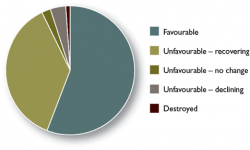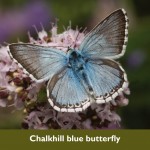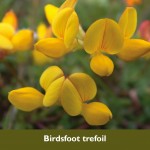
Chalk downland is a big part of what makes the South Downs special. Chalk downland is made up of a mosaic or patchwork, of habitats including chalk grassland, chalk heath, scrub, and dew ponds.
Although there appears to be a lot of chalk in the south of England, it is rare in the world as a whole. Chalk grassland is one of the richest habitats of Western Europe, containing many different types of plant and animal. However, not much of it is left, so we need to look after what remains. In the South Downs National Park 4% of the land is chalk grassland.
Chalk grassland only occurs on thin soils covering chalk rocks, as in the South Downs. These soils are well drained and poor in plant foods. As the rainwater soaks through the chalk it takes with it the minerals needed for plants to grow. So the plants which do manage to grow on this poor soil are in strong competition with their neighbours for the plant foods which they need.
This high level of competition results in very many different types of plants growing in a small area because no one plant can outgrow the others. If the soil was deeper and richer or if fertiliser was put on, a few strong plants would take over and the variety would be lost.
In chalk grassland the short, springy grass supports many animals and plants. The right amount of grazing by animals is essential to keep the grass short and to prevent the growth of unwanted plants. Chalk grassland may contain up to 40 different kinds of plants per square metre. This diversity means that there are also many types of insect. You can find rare plants such as the round-headed rampion, orchids ranging from the burnt orchid and early spider orchid to autumn lady’s tresses, and butterflies including the Adonis blue and chalkhill blue.
Scrub consists of common low-growing shrubs or bushes such as hawthorn, blackthorn and the yellow-flowered gorse. However, we must not underestimate the value of scrub, because many different types of plant and animal live in or near it. It should be actively conserved and managed, to make sure it does not spread too much across the delicate grassland.
Chalk grassland has suffered badly from loss and fragmentation both nationally and within the National Park. In February 2012 the South Downs National Park was awarded £608,000 towards a £3 million plan to safeguard endangered chalk downland. The South Downs Way Ahead project brings together 29 organisations, led by the South Downs National Park Authority, to trail blaze the Government’s new Nature Improvement Area scheme to protect habitats and the environmental, economic and social benefits they bring.
Resources Toolbox
EYFS
Ages 1–5
Pre School
Key Stage 1
Ages 5–7
Years 1 and 2
Key Stage 2
Ages 7–11
Years 3, 4, 5 and 6
Key Stage 3
Ages 11–14
Years 7, 8 and 9
-

Chalk Grassland
Introducing chalk grasslands - the European equivalent of tropical rainforests. Covers what they are, where they are found, how they were formed and why its important to look after them. Also looks at what is being done locally in the South Downs to conserve and improve them for the future. -

Chalk Grassland Super Species
A set of 13 top trumps style cards with images and information about chalk grassland specialist species.
Key Stage 4
Ages 14–16
Years 10 and 11
Key Stage 5
Ages 16–18
Years 12 and 13









